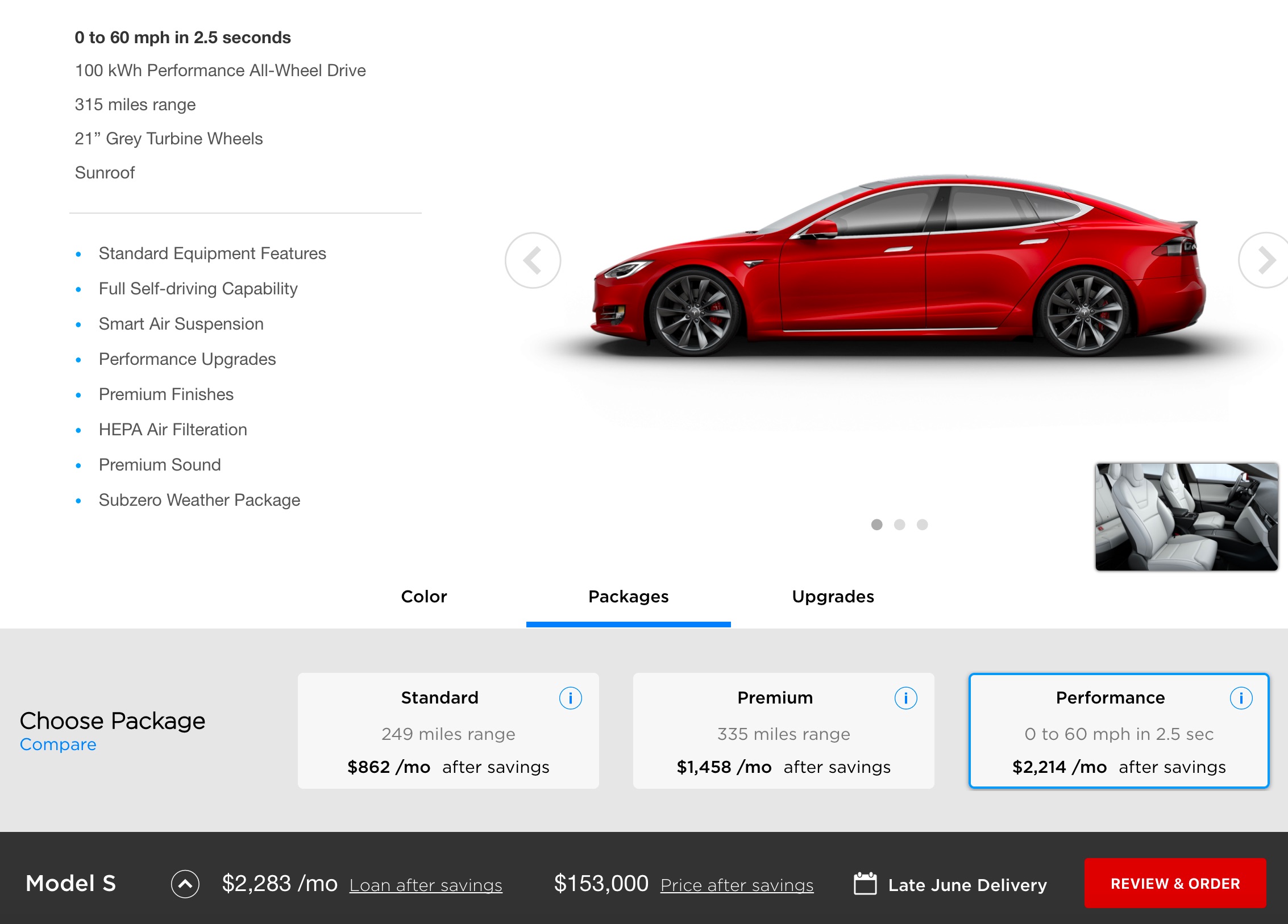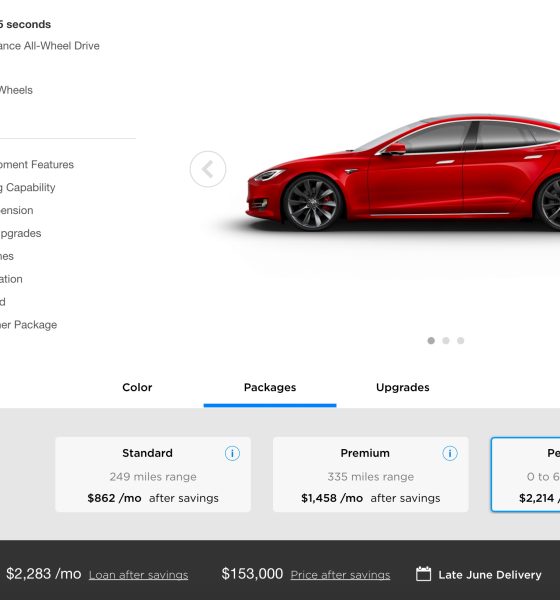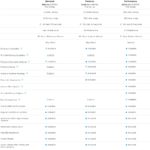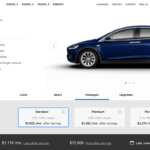

News
Tesla will bundle car buying into “packages”, 90 kWh battery discontinued June 8
Tesla will launch an updated version of the Model S and Model X Design Studio that “packages” vehicle configurations into three categories: standard, premium and performance. The update will come ahead of the company’s planned production of its $35k mass market Tesla Model 3, and is likely a precursor to what the Model 3 online configurator will eventually look like.
Also spotted in the newly designed online vehicle configurator is the removal of the 90 kWh battery pack option that’s currently planned for discontinuation on June 8, according to sources and also validated by our friends at Model 3 Owners Club. Model S and Model X buyers will choose from either a “standard” configuration with a 75 kWh battery pack that’s capable of 249 miles of range on the Model S and 237 miles on the Model X, or a “premium” configuration that utilizes Tesla’s long-range 100 kWh battery pack. Model S will be capable of 335 miles of range on the 100 kWh pack while Model X will have just shy of a 300-mile-range per single charge. Lastly, adrenaline junkies will be able to select the “performance” package that trades driving range for increased acceleration.
The Design Studio redesign comes shortly after Tesla published a chart comparing the Model S and Model 3 that seems to clearly push their “anti-sell Model 3” approach. The chart reveals Tesla’s drastically reduced number of configurations being made available for Model 3, at less than 100, and over 1,500 possible configurations for Model S.
Comparing Model S vs Model 3 https://t.co/JPM9VVGbhA
— Elon Musk (@elonmusk) May 26, 2017
Tesla’s newest Design Studio with “packages” aims to simplify the car buying experience, but more importantly is a move that allows its production line to operate more efficiently by reducing the number of unique car configurations that can be built. Producing cars with like-kind features allows the factory team to build at faster speeds, with less complexity and at a lower cost.
ALSO SEE: Which Tesla Model 3 customizations will be available to initial buyers?
Tesla invested heavily into designing the Model 3 for scale. The Silicon Valley electric car maker underwent a full redesign of the manufacturing equipment used on its vehicle production line. Tesla also purchased German automation company Grohmann Engineering to form Tesla Advanced Automation Germany which reveals that the company will go to extreme lengths to truly optimize its manufacturing process.
On the new online Design Center configurator, customers can click on the Compare button in the lower left corner to pull up the full list of detailed options in each of the three major packages.
Tesla has previously pushed to optimize its offerings with the constant refinement of battery pack sizes and discontinuation of unpopular options. Further updates to the battery packs, like upgrading the Model S and Model X battery to utilize the new high energy density 2170 lithium ion cell being used in Model 3, are expected in the near future as Tesla’s Gigafactory begins volume production of battery cells.
Buyers looking for more granularity in terms of options will still be to use the original configurator.

Elon Musk
Starlink passes 9 million active customers just weeks after hitting 8 million
The milestone highlights the accelerating growth of Starlink, which has now been adding over 20,000 new users per day.

SpaceX’s Starlink satellite internet service has continued its rapid global expansion, surpassing 9 million active customers just weeks after crossing the 8 million mark.
The milestone highlights the accelerating growth of Starlink, which has now been adding over 20,000 new users per day.
9 million customers
In a post on X, SpaceX stated that Starlink now serves over 9 million active users across 155 countries, territories, and markets. The company reached 8 million customers in early November, meaning it added roughly 1 million subscribers in under seven weeks, or about 21,275 new users on average per day.
“Starlink is connecting more than 9M active customers with high-speed internet across 155 countries, territories, and many other markets,” Starlink wrote in a post on its official X account. SpaceX President Gwynne Shotwell also celebrated the milestone on X. “A huge thank you to all of our customers and congrats to the Starlink team for such an incredible product,” she wrote.
That growth rate reflects both rising demand for broadband in underserved regions and Starlink’s expanding satellite constellation, which now includes more than 9,000 low-Earth-orbit satellites designed to deliver high-speed, low-latency internet worldwide.
Starlink’s momentum
Starlink’s momentum has been building up. SpaceX reported 4.6 million Starlink customers in December 2024, followed by 7 million by August 2025, and 8 million customers in November. Independent data also suggests Starlink usage is rising sharply, with Cloudflare reporting that global web traffic from Starlink users more than doubled in 2025, as noted in an Insider report.
Starlink’s momentum is increasingly tied to SpaceX’s broader financial outlook. Elon Musk has said the satellite network is “by far” the company’s largest revenue driver, and reports suggest SpaceX may be positioning itself for an initial public offering as soon as next year, with valuations estimated as high as $1.5 trillion. Musk has also suggested in the past that Starlink could have its own IPO in the future.
News
NVIDIA Director of Robotics: Tesla FSD v14 is the first AI to pass the “Physical Turing Test”
After testing FSD v14, Fan stated that his experience with FSD felt magical at first, but it soon started to feel like a routine.

NVIDIA Director of Robotics Jim Fan has praised Tesla’s Full Self-Driving (Supervised) v14 as the first AI to pass what he described as a “Physical Turing Test.”
After testing FSD v14, Fan stated that his experience with FSD felt magical at first, but it soon started to feel like a routine. And just like smartphones today, removing it now would “actively hurt.”
Jim Fan’s hands-on FSD v14 impressions
Fan, a leading researcher in embodied AI who is currently solving Physical AI at NVIDIA and spearheading the company’s Project GR00T initiative, noted that he actually was late to the Tesla game. He was, however, one of the first to try out FSD v14.
“I was very late to own a Tesla but among the earliest to try out FSD v14. It’s perhaps the first time I experience an AI that passes the Physical Turing Test: after a long day at work, you press a button, lay back, and couldn’t tell if a neural net or a human drove you home,” Fan wrote in a post on X.
Fan added: “Despite knowing exactly how robot learning works, I still find it magical watching the steering wheel turn by itself. First it feels surreal, next it becomes routine. Then, like the smartphone, taking it away actively hurts. This is how humanity gets rewired and glued to god-like technologies.”
The Physical Turing Test
The original Turing Test was conceived by Alan Turing in 1950, and it was aimed at determining if a machine could exhibit behavior that is equivalent to or indistinguishable from a human. By focusing on text-based conversations, the original Turing Test set a high bar for natural language processing and machine learning.
This test has been passed by today’s large language models. However, the capability to converse in a humanlike manner is a completely different challenge from performing real-world problem-solving or physical interactions. Thus, Fan introduced the Physical Turing Test, which challenges AI systems to demonstrate intelligence through physical actions.
Based on Fan’s comments, Tesla has demonstrated these intelligent physical actions with FSD v14. Elon Musk agreed with the NVIDIA executive, stating in a post on X that with FSD v14, “you can sense the sentience maturing.” Musk also praised Tesla AI, calling it the best “real-world AI” today.
News
Tesla AI team burns the Christmas midnight oil by releasing FSD v14.2.2.1
The update was released just a day after FSD v14.2.2 started rolling out to customers.

Tesla is burning the midnight oil this Christmas, with the Tesla AI team quietly rolling out Full Self-Driving (Supervised) v14.2.2.1 just a day after FSD v14.2.2 started rolling out to customers.
Tesla owner shares insights on FSD v14.2.2.1
Longtime Tesla owner and FSD tester @BLKMDL3 shared some insights following several drives with FSD v14.2.2.1 in rainy Los Angeles conditions with standing water and faded lane lines. He reported zero steering hesitation or stutter, confident lane changes, and maneuvers executed with precision that evoked the performance of Tesla’s driverless Robotaxis in Austin.
Parking performance impressed, with most spots nailed perfectly, including tight, sharp turns, in single attempts without shaky steering. One minor offset happened only due to another vehicle that was parked over the line, which FSD accommodated by a few extra inches. In rain that typically erases road markings, FSD visualized lanes and turn lines better than humans, positioning itself flawlessly when entering new streets as well.
“Took it up a dark, wet, and twisty canyon road up and down the hill tonight and it went very well as to be expected. Stayed centered in the lane, kept speed well and gives a confidence inspiring steering feel where it handles these curvy roads better than the majority of human drivers,” the Tesla owner wrote in a post on X.
Tesla’s FSD v14.2.2 update
Just a day before FSD v14.2.2.1’s release, Tesla rolled out FSD v14.2.2, which was focused on smoother real-world performance, better obstacle awareness, and precise end-of-trip routing. According to the update’s release notes, FSD v14.2.2 upgrades the vision encoder neural network with higher resolution features, enhancing detection of emergency vehicles, road obstacles, and human gestures.
New Arrival Options also allowed users to select preferred drop-off styles, such as Parking Lot, Street, Driveway, Parking Garage, or Curbside, with the navigation pin automatically adjusting to the ideal spot. Other refinements include pulling over for emergency vehicles, real-time vision-based detours for blocked roads, improved gate and debris handling, and Speed Profiles for customized driving styles.











